Centauri Dreams
Imagining and Planning Interstellar Exploration
Wolf 1061c: A Nearby Habitable Zone Planet?
At no more than 14 light years away, Wolf 1061 gains our attention with the discovery that this small red dwarf hosts three planets, in orbits of 4.9, 17.9 and 67.2 days respectively. Of particular interest is Wolf 1061c, which appears to be within the habitable zone, defined here as the region in which it would be possible for liquid water to exist on the surface, and potentially life. Wolf 1061c has a mass at least 4.3 times that of Earth, with inner planet Wolf 1061b coming in at 1.4 times that mass. Wolf 1061d is calculated to be at least 5.2 times Earth’s mass.
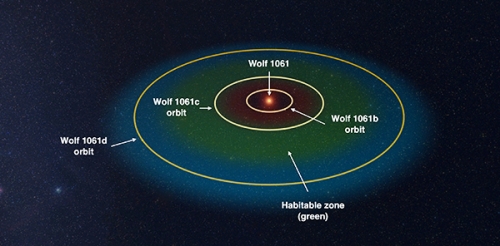
Image: The Wolf 1061 system, with the habitable zone depicted in green. Credit: University of New South Wales.
One thing Wolf 1061 reminds us is that red dwarf stars are good targets for radial velocity studies. For one thing, such stars have low levels of luminosity, which means their habitable zones are small and planets within them are in close orbits. Such planets create a stronger, more detectable signature for instruments using Doppler methods, a fact that is intensified by the typically low mass of the star. The paper on this work adds that M-dwarfs also show sharp molecular absorption features and typically have slow rotation speeds.
The current work, led by Duncan Wright at the University of New South Wales, is based on data from the HARPS spectrograph (High Accuracy Radial Velocity Planet Searcher) installed on the European Southern Observatory’s 3.6m telescope at La Silla. Long-term monitoring data on more than a hundred M-dwarfs is found within the HARPS database. 148 HARPS spectra for Wolf 1061 are available here, taken over a period of 10.3 years. Wright and team have found a more precise way to extract Doppler signals from the HARPS data reduction software (DRS) by creating a custom mask generated from within the data for the star.
The template is, in other words, custom-built for the particular star under study, with details supplied in the paper. For our purposes, the results for the two outer planets stand out. From the paper:
The 17.867 d planet is of particular interest because it is of sufficiently small mass to be rocky and is in the habitable zone of the host M dwarf star. The probable outer planet at 67.274 d resides just on the outer boundary of the habitable zone and is also likely rocky. These planets join the small but growing ranks of potentially habitable rocky worlds orbiting nearby M dwarf stars.
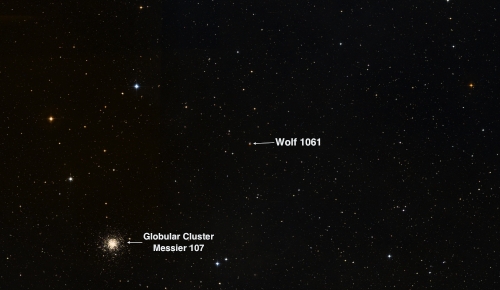
Image: The sky area in the constellation of Ophiucus near the red dwarf star Wolf 1061 which includes the impressive, but unrelated, star cluster Messier 107. Wolf 1061 is 14 light years away. Credit: The “Aladin sky atlas” developed at CDS, Strasbourg Observatory, France.
But we may be able to deploy other tools besides radial velocity, for the paper argues that the strong Doppler signals may be supplemented by transits, considering how short the orbital periods of these planets are. The transit probabilities are listed as 14 percent for planet b, 5.9 percent for planet c, and 2.6 percent for planet d. These would be transits that are detectable from ground-based telescopes given the transit depths the authors estimate, which would make Wolf 1061 an excellent target for projects like MEarth (a robotic observatory on Mt. Hopkins, AZ) and MINERVA (MINiature Exoplanet Radial Velocity Array, also on Mt. Hopkins).
The paper is Wright et al., “Three planets orbiting Wolf 1061,” to be published by The Astrophysical Journal Letters (preprint).

Oxygenation: Gradual Process, Profound Results
The vast changes our planet has undergone since formation add a real sense of humility to the exoplanet hunt. It’s the humility that comes with exposure to deep time, reminding us that worlds like ours have developed through phases wildly different than the conditions we experience today. As we tune up our techniques for studying rocky worlds, we’ll find planets in entirely different states of their own evolution, perhaps some with life, and some young enough to be life’s future home. Perhaps some will be worlds where life has come, and gone.
We have much to learn about how our own planet developed life, and new work from an international team led by Philip Pogge von Strandmann (University College London) gives us insight into a key issue: How long did it take for oxygen levels in the oceans and atmosphere to increase to the point that animal life could take off some 600 million years ago? Underlying the question is how the evolution of life ties in to changes in climate. For it seems likely that increased oxygen was the factor that brought about the first major expansion of animal life.
Co-author David Catling (University of Washington) defines the issue this way:
“Oxygen was like a slow fuse to the explosion of animal life. Around 635 Ma, enough oxygen probably existed to support tiny sponges. Then, after 580 Ma, strange creatures, as thin as crêpes, lived on a lightly oxygenated seafloor. Fifty million years later, vertebrate ancestors were gliding through oxygen-rich seawater. Tracking how oxygen increased is the first step towards understanding why it took so long. Ultimately, a grasp of geologic controls on oxygen levels can help us understand whether animal-like life might exist or not on Earth-like planets elsewhere.”
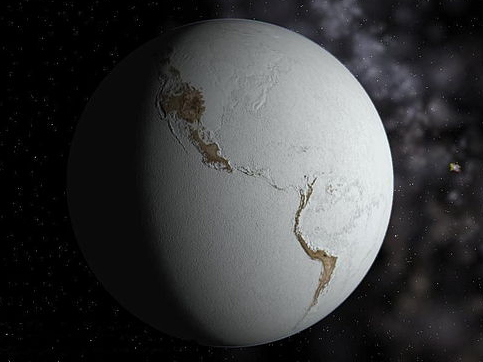
Image: Artist’s conception of a ‘snowball Earth.’ Credit: Neethis / Wikimedia Commons.
The researchers measured selenium isotopes in rock samples laid down under the ocean to track oxygen levels from 770 to 525 million years ago (across the full period believed to be covered by what is known as the Neoproterozoic Oxygenation Event). The marine shales are drawn from seven different geological sections, with samples from Canada (the Mackenzie Mountains), China (the so-called Yangtze Platform), Australia and the western US.
This is a fascinating period because three major glaciation events occurred during it: The Sturtian (‘snowball Earth’) of roughly 716 million years ago, the Marinoan (635 million years ago, or 635Ma), and the Gaskiers glaciation (about 580 Ma).
This would be a planet that looked nothing like what we’re familiar with, as the image above suggests. The land would have been covered in ice and the oceans frozen all the way to the equatorial regions. Temperature changes as these eras progressed would in each case melt the glaciers and produce a flow of nutrients into the oceans, one that would build the levels of organic carbon in seafloor sediments as oceanic plankton that flourished from that flow died. The growth in such carbon would lead to gradual increases in the level of oxygen.
A key finding of the paper is that rather than occurring after the Gaskiers glaciation, the oxygenation began much earlier, during or at the end of the Marinoan glaciation. From the paper:
“…the significance of the Se isotope record is not only that it adds to growing evidence that the late Proterozoic and Cambrian ocean and atmosphere reached a progressively more oxic state, coinciding with the diversification of animal life, but also that the process of oxidation was protracted, and not ultimately triggered by the Gaskiers deglaciation, as other data suggest.”
Moreover, it took approximately 100 million years for atmospheric oxygen to climb from less than 1 percent to over ten percent of today’s level. The occurrence of oxygenation in fits and starts over such a lengthy period of time is evidence, the team believes, that early animal evolution received its needed boost from these increased levels of oxygen. Says Pogge von Strandmann: “We were surprised to see how long it took Earth to produce oxygen and our findings dispel theories that it was a quick process caused by a change in animal behaviour.”
The paper is von Strandmann et al., “Selenium isotope evidence for progressive oxidation of the Neoproterozoic biosphere,” Nature Communications 6, article number 10157, published online 18 December 2015 (full text). A UCL news release is also available.

Where Are the Jupiter Analogs?
Are Solar Systems like ours commonplace? One way of answering this is to look at the role of planets like Jupiter, which may have helped to determine the habitability of the inner planets. But worlds like Jupiter in orbits around 5 AU do not appear to be the norm, as Andrew LePage points out in this discussion of a new exoplanet find. LePage, publisher of an essential site on exoplanet detection (www.DrewExMachina.com) is also a Senior Project Scientist at Visidyne, Inc. in Boston. Today he shows us what we know and just how much we still need to clarify about the occurence of planets like Jupiter and their role in system habitability.
By Andrew J. LePage

A couple of decades ago, astronomers thought they had planetary systems figured out: they consisted of a more or less orderly set of worlds orbiting in the same plane with small rocky worlds close in and much larger, volatile-rich planets orbiting farther out beyond the “snow line” where plentiful water freezes into solid ice. Along with this model came the view among some that the presence of large Jupiter-like planets was not only likely but required to deliver water and clear out potential impact hazards to ensure the habitability of smaller rocky worlds orbiting inside a star’s habitable zone. Coupled with the Copernican principle that implies that there is nothing special about our Solar System, it was expected that extrasolar planetary systems would have similar architectures and possess “Jupiter analogs”.
But with the discovery of the first extrasolar planet orbiting a main sequence star back in 1995, this orderly view of planetary systems was called into question. This first exoplanet, 51 Pegasi b, was a Jupiter-mass world in a four-day orbit only 8 million kilometers from its sun. This “hot Jupiter” and a host of other extrasolar giant planets (EGPs) discovered since with a wide range of orbital radii clearly demonstrated that other arrangements of planetary systems are possible and that Jupiter analogs might not be the norm after all. Unfortunately, getting a clear picture of exoplanetary systems has been difficult because of the detection biases of the most often used detection techniques (i.e. precision radial velocity measurements and transit observations) clearly favor finding large planets in small orbits with short periods. But with two (and sometimes more) decades of data from various long-running radial velocity surveys now available for analysis, this is beginning to change as it now becomes possible to detect EGPs with orbital periods of a decade or more.
Earlier this month, the team responsible for Lick-Carnegie Exoplanet Survey announced the latest discovery of a Jupiter analog in a paper accepted for publication in The Astrophysical Journal. What makes this discovery all the more interesting is that the lead author, Dominick Rowan, is a senior at Byram Hills High School in Armonk, New York. Rowan recently won individual top honors in the Regional Finals of the Siemens Competition in Math, Science & Technology as a result of his work described in this paper. The newest Jupiter analog found by Rowan et al. orbits the Sun-like star HD 32963 about 120 light years away. With a mass estimated to be 94% that of the Sun, this star has a luminosity of about 90% of the Sun’s and an estimated age of around five billion years.
To find the new Jupiter analog, designated HD 32963b, a total of 199 radial velocity measurements acquired over 16 years using HIRES (High Resolution Echelle Spectrometer) on the 10-meter Keck I telescope at Mauna Kea, Hawaii were analyzed. These data were placed into two-hour bins to create 109 individual radial velocity measurements with a typical uncertainty of ±1.2 meters/second. A clear signal with a semiamplitude of 11 meters/second and a period of 6.49 years was seen in the data with only a 2×10-5 false alarm probability. This signal indicates the presence of a planet in a nearly circular 3.4 AU orbit – only a touch smaller than Jupiter’s 5.2 AU orbit around the Sun. Since the tilt of the new planet’s orbit with respect to the plane of the sky is not known, only the minimum mass or Mpsini of 0.70 times that of Jupiter (or MJ) can be determined using radial velocity measurements alone. By assuming a randomly oriented orbit, there is less than a one in three chance that HD 32963b is more massive than Jupiter.
Rowan et al. took their analysis one step further and examined the data from the Lick-Carnegie Exoplanet Survey to determine the occurrence rate of Jupiter analogs around Sun-like stars. For the purpose of this analysis, a Jupiter analog was defined as an EGP with a mass in the 0.3 to 3 MJ range orbiting a Sun-like star with an eccentricity less than 0.3 and a period of between 5 to 15 years (which corresponds roughly to orbital radii in the 3 to 6 AU range). The new find by Rowan et al. qualifies as a Jupiter analog by this definition.
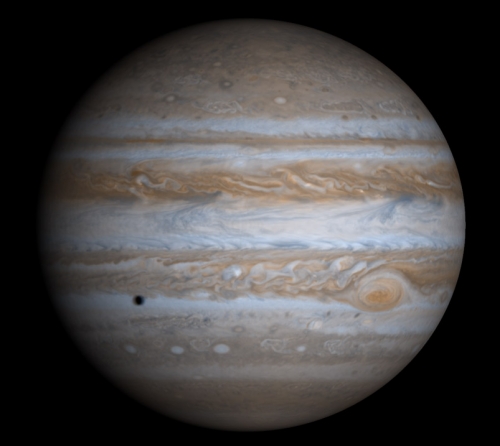
Image: Jupiter dominates our Solar System and may have had a role to play in the habitability of our own planet. We’re only now learning, however, how common such worlds are in orbits comparable to our own Jupiter’s at 5 AU. Credit: NASA/JPL/University of Arizona.
A review of the Exoplanet Data Explorer in August 2015 revealed 21 EGPs that met the working definition for Jupiter analog. Of these, eight published exoplanets that met the baseline requirements were found among the 1,120 Sun-like stars in the Lick-Carnegie Exoplanet Survey, yielding a raw frequency rate of 0.71%. In order to turn this raw number into a meaningful occurrence rate, the detection efficiency of the radial velocity survey for this class of planet must be taken into account. To accomplish that, Rowan et al. created synthetic radial velocity data sets for each star in their survey representing 320,000 different combinations of various planetary mass and orbital parameters. The ability of their analysis algorithms to detect these velocity variations through the noise in the data was then gauged to determine the detection efficiency.
The analysis by Rowan et al. found that the occurrence rate of Jupiter analogs orbiting Sun-like stars as defined here was approximately 3%. Making reasonable assumptions about the possible distribution of EGP properties, the rate can not be less than about 1% nor greater than around 4%. These results roughly agree with earlier studies based on microlensing and long-term radial velocity surveys. This suggests, contrary to earlier expectations, that Jupiter analogs are not common. This finding implies that either planet migration mechanisms from the snow line are very efficient at moving EGPs into smaller orbits or that EGPs have a difficult time forming at distances of about 5 AU.
But before the alarms are sounded by “rare Earth” advocates about the relative rarity of Jupiter analogs, it remains to be seen just how vital Jupiter analogs are to planetary habitability given the spectrum of architectures observed in exoplanet surveys to date. Even if Jupiter analogs prove to be required, current surveys have yet to search effectively for smaller Neptune to Saturn-size worlds at distances of about 5 AU or for EGPs at greater distances which may suffice as “Jupiter surrogates”. Only continued collection of radial velocity data along with new surveys, such as the current Gaia astrometry mission and the new generation of telescopes to image exoplanets directly, will allow us to fill in the missing pieces of our knowledge of exoplanetary systems. Thankfully this ongoing search provides opportunities for aspiring young scientists like Dominick Rowan.
The paper is Rowan et al. “The Lick-Carnegie Exoplanet Survey: HD32963 — A New Jupiter Analog Orbiting a Sun-like Star” accepted for publication in The Astrophysical Journal (preprint).

E-22: The Last Hurrah at Enceladus
It’s the end of an era. On Saturday December 19, the Cassini Saturn orbiter will make its final close pass by Enceladus. This doesn’t mark the end of Cassini itself, which still has work to do especially with regard to Titan, but it does mean the end, at least for now, of our close-up study of a remarkable phenomenon: The plumes of Enceladus, which Cassini itself discovered. We’ve gained priceless data through its flybys, helping us make the case for an internal ocean.
Cassini will continue to observe Enceladus until mission’s end, but only from much greater distances. In fact, as this JPL news release explains, the closest Cassini will come to Enceladus after Saturday is about four times the distance of the upcoming flyby. Nor will the Saturday event be as close a pass as Cassini’s dive through the south polar plume on October 28. That one took the spacecraft within a scant 49 kilometers of the surface, returning data that is still undergoing analysis as we probe the plume’s activity. A key issue: Is there hydrogen gas here, which would offer yet more evidence for active hydrothermal systems on the seafloor?
Image: An animation showing the upcoming December 19 flyby of Enceladus, in which Cassini’s composite infrared spectrometer instrument will observe the moon’s south polar terrain. Credit: NASA/JPL.
The Saturday event will be all about measuring the moon’s heat, a critical factor in making sense of the factors driving the spray of particles and gas from the ocean beneath. 5000 kilometers turns out to be about the right distance to allow the best working of Cassini’s Composite Infrared Spectrometer (CIRS) as it maps the heat flow across the southern polar region, according to Mike Flasar, CIRS team lead at NASA GSFC:
“The distance of this flyby is in the sweet spot for us to map the heat coming from within Enceladus — not too close, and not too far away. It allows us to map a good portion of the intriguing south polar region at good resolution.”
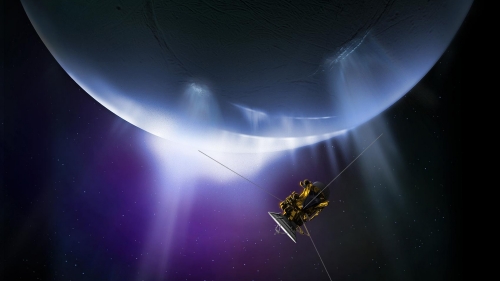
Image: An exciting chapter of space exploration history will come to a close as NASA’s Cassini spacecraft makes its final close flyby of Saturn’s active, ocean-bearing moon Enceladus. The spacecraft is scheduled to fly past the icy moon at a distance of 4,999 kilometers on Dec. 19 at 0949 PST (1749 UTC). Although Cassini will continue to observe Enceladus for the remainder of its mission (through Sept. 2017), its next-closest encounter with the moon will be at a distance more than four times farther away. The focus of the Dec. 19 encounter will be on measuring how much heat is coming through the ice from the moon’s interior — an important consideration for understanding what is driving its surprising geyser activity, which Cassini discovered in 2005. Credit: NASA/JPL-CalTech.
Keep in mind that the south polar region of Enceladus was well lit when Cassini arrived at Saturn in 2004, but at present the area is in winter darkness, making these heat studies that much easier to complete absent the heat of the Sun. By mission’s end, we will have data on six years of winter darkness in the south polar area. The discovery of geologic activity caused the mission’s flight plan to be changed to make Enceladus a prime target of operations. Of all the gifts Cassini has given us, finding a global ocean beneath the ice glitters the most brightly.

Naming New Worlds
I can only wonder what Miguel de Cervantes Saavedra would have thought of the idea that a distant star would one day be named for him. I wonder, too, what the Spanish novelist (1547-1616) would have made of the idea that planets circled other stars, and that planets around the star named for him would have names taken from his most famous work, Don Quixote. Maybe the great character of the book’s title, obsessed with tales of chivalry, would have been unhinged enough to take things like other solar systems in stride.

We have the NameExoWorlds contest to thank for these speculations. The contest, organized by the International Astronomical Union (IAU) gave the public the opportunity to choose the names of selected stars and planets. The star named for Cervantes is mu Arae (HD 160691), a G-class star about fifty light years out in the constellation Ara (the Altar). Here we’ve found three gas giant planets comparable to Jupiter as well as a ‘super-Earth.’ And frankly, as a reader who agrees with Schopenhauer that Don Quixote is one of the world’s great novels, I am delighted with what the public has chosen, at least for this star.
Image: Portrait of Miguel de Cervantes y Saavedra (1547-1615), by the artist Juan de Jauregui y Aguilar (circa 1583-1641). Credit: Bridgeman Art Library.
For mu Arae b becomes Quijote, while mu Arae c is Dulcinea. The system is rounded out with Rocinante (mu Arae d) and Sancho (mu Arae e). Names as enchanting as these, with roots in classic literature, are likely to stick. When the voting finished at the end of October, the IAU had received 573,242 votes, which went toward naming 14 host stars and 31 exoplanets. Names were submitted from astronomy organizations in 45 countries, everything from amateur astronomy clubs to universities and planetariums, drawn from a wild variety of sources.
Take Thestias, the planet depicted in the image below. The grandfather of Pollux, Thestias orbits the star of the same name (Pollux, already named, needs no further designation). In Greek mythology, Pollux and Castor were twin brothers known as the Dioscuri who became transformed at death into the constellation Gemini. The winning name came from SkyNet, an astronomy project based at the International Centre for Radio Astronomy Research (ICRAR) in Perth, Australia. The group, which includes over 200,000 volunteers globally, arrived at the submission by an internal vote, drawing on the idea of volunteer Rich Matthews.
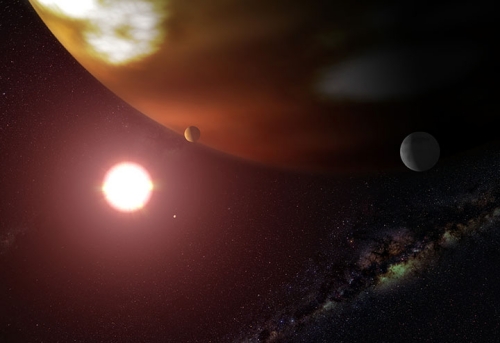
Image: Artist’s impression of Thestias around its star Pollux. Credit: NASA/ESA and G. Bacon (STScI).
If mu Arae taps the late European Renaissance for its inspiration, 47 Ursae Majoris (46 light years out) draws on Thai folklore. The star receives the name Chalawan, while 47 Ursae Majoris b becomes Taphao Thong and 47 Ursae Majoris c is Taphao Kaew, these being two sisters in the story of a mythological crocodile king. The star upsilon Andromedae (an F-class star 44 light years away) becomes Titawin, a point of contact in Morocco between Spaniards and Arabs after the 8th Century. The planets upsilon Andromedae b, c and d become Saffar, Samh and Majriti, names drawn from astronomers and mathematicians notable in 11th Century Spain.
I think some of these names will last, but I’m not at all sure why the IAU chose to put out a call for new names for epsilon Eridani, at 10.5 light years one of the closest stars and a familiar name to generations of science fiction readers. I’m OK with giving epsilon Eridani b the name AEgir, which is drawn from Norse mythology (he was husband to Ran, the goddess of the sea), but changing the star epsilon Eridani to Ran is just not going to work, the original name being too widely circulated. It’s as odd as if we named the three Centauri stars anything other than their designation, the point being that by wide use, the designation and the name are one.
18 Delphini gets tagged Musica (lovely!), while its planet 18 Delphini b is now the wisely chosen Arion, a Greek musician whose tunes attracted the dolphins who saved him at sea. It’s also heartening to see the 55 Cancri planets named for great figures in astronomy including Galileo and Brahe, while the star itself becomes Copernicus. But is Poltergeist going to survive as the name of one of the pulsar planets (PSR 1257+12 c)? How about Spe for 14 Andromedae b?
My cavils aside, I love the idea of pulling the public into the naming of planets because we live in a world undergoing an unprecedented expansion of consciousness skyward. The great voyages of discovery have nothing on what we are doing now, pushing away from Sol to find planets at ever smaller and more Earth-like scale as we begin, in the tiniest way, the process of mapping the planetary systems of a galaxy of 200 billion stars. Ultimately, naming exoplanets will by necessity become an ad hoc process, to be resorted to as needed, because the number of planets will dwarf our lexicons. But we’re still getting used to that idea, and the NameExoWorlds contest has been a delightful way to bring visibility to the question.

‘Hot Jupiters’: Water Depletion Explained
Planets that transit across their star as seen from Earth allow us to use transmission spectroscopy to study their atmospheres. The idea is straightforward: Even though we can’t see the planet at optical wavelengths, we can examine the starlight that travels through its outer atmosphere during the transit. Each atmosphere leaves its own signature, and the atmospheres of some of the ‘hot Jupiters’ thus far studied have raised questions. Why do some of these worlds have less water than our models of their atmospheres would predict? Is this an indication that such planets formed in protoplanetary disks that were depleted of water?
A new study brings us some answers by going to work on eight hot Jupiters (WASP-6b, WASP-12b, WASP-17b, WASP-19b, WASP-31b, WASP-39b, HAT-P-1b and HAT-P-12b) using the Hubble Space Telescope. The worlds chosen here offer a wide range of temperature, surface gravity, mass and radii. All eight were observed at optical wavelengths using Hubble’s Space Telescope Imaging Spectrograph (STIS) instrument, while two of them (WASP-31b and HAT-P-1b) were also observed in the near infrared with Hubble’s Wide Field Camera 3.
But lead author David Sing (University of Exeter) and team did not stop there. The Hubble survey was bolstered by infrared data from the Spitzer Space Telescope, and the work folded in data from both HST and Spitzer on two of the most widely studied hot Jupiters, HD 209458b and HD 189733b. Although we’re only dealing with ten worlds, this turns out to be the largest spectroscopic catalog of exoplanet atmospheres yet assembled.
What we learn is that these planets show a continuum from completely clear to cloudy atmospheres. It turns out that the difference between a planet’s radius as measured at optical and infrared wavelengths allows us to distinguish between the two types. A cloudy planet shows up larger in visible light than it does in the infrared — at the latter wavelengths, we are looking deeper into the atmosphere. The paper notes the significance of this finding:
We find that the difference between the planetary radius measured at optical and infrared wavelengths is an effective metric for distinguishing different atmosphere types. The difference correlates with the spectral strength of water, so that strong water absorption lines are seen in clear-atmosphere planets and the weakest features are associated with clouds and hazes. This result strongly suggests that primordial water depletion during formation is unlikely and that clouds and hazes are the cause of weaker spectral signatures.
In other words, the clouds are the culprit, and ‘dry’ hot Jupiters are not depleted in water.
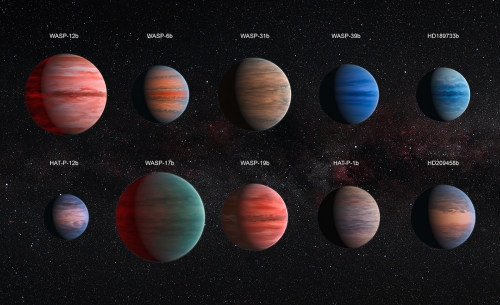
Image: This image shows an artist’s impression of the 10 hot Jupiter exoplanets studied by astronomer David Sing and his colleagues using the Hubble and Spitzer space telescopes. From top left to lower left, these planets are WASP-12b, WASP-6b, WASP-31b, WASP-39b, HD 189733b, HAT-P-12b, WASP-17b, WASP-19b, HAT-P-1b and HD 209458b. Credit: NASA, ESA, D. Sing (University of Exeter).
A couple of things to note in the image. The colors are vivid but as this Hubblesite news release explains, they are purely for illustrative purposes. We have little data on the color of any of these worlds with the exception of HD 189733b, sometimes called the ‘blue planet.’ The cloud patterns shown here are also theoretical, based largely on what we see on Jupiter.
An interesting difference between hot Jupiters and brown dwarfs emerges in this paper. With the latter, which can have temperatures similar to hot Jupiters, we can go from warmer, cloudy L-class dwarfs to cooler T-dwarfs whose atmospheres are inferred to be clear — the paper calls this sequence ‘well defined.’ In contrast, hot Jupiters do not show a strong relationship between temperature and cloud formation, at least based on this sample, where both cloudy and not cloudy planets appear throughout the temperature range studied. The authors speculate on the difference:
We suggest that the difference between hot Jupiters and brown dwarfs is due to the vertical temperature structure of hot-Jupiter atmospheres. Hot Jupiters have very much steeper pressure-temperature profiles compared to isolated brown dwarfs, owing to the strong incident stellar flux heating the top of the planetary atmosphere… Since cloud condensation curves run nearly parallel to hot-Jupiter profiles, a relatively small temperature shift (about 100K) could easily move a cloud base by a factor of tens or hundreds in pressure, in or out of the visible atmosphere.
Moreover, some hot Jupiters are likely to have cloud materials that are cold-trapped deep within the atmosphere, and thus out of the range we can detect. The paper adds that hot Jupiters show a wider range of gravities and metallicities than brown dwarfs, factors that play a role in atmospheric circulation and condensation as well as temperature. As we learn more about how to distinguish between clear and cloudy atmospheres, we’ll strengthen our ability to focus on worlds with clear skies whose chemical abundances can be studied in greater detail.
The paper is Sing et al., “A continuum from clear to cloudy hot-Jupiter exoplanets without primordial water depletion,” published online in Nature 14 December 2015 (abstract).


